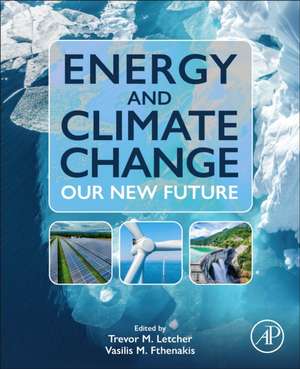Energy and Climate Change: Our New Future
Editat de Trevor Letcher, Vasilis M. Fthenakisen Limba Engleză Paperback – 28 feb 2025
This is an invaluable resource for all those with an interest in energy transition, renewable energy, climate change, and sustainability, including researchers, graduate students, scientists, engineers, practitioners, consultants, industry leaders, urban planners, and government personnel.
- Explains the fundamentals of climate change, global warming, energy transition, and future energy, and the connections between them
- Reviews current options and future pathways in the transition to non-fossil fuel energy systems, including environmental impact, safety, and potential capacity
- Offers complete, authoritative coverage written by leading global experts
Preț: 1098.13 lei
Preț vechi: 1442.57 lei
-24% Nou
Puncte Express: 1647
Preț estimativ în valută:
210.12€ • 219.41$ • 173.51£
210.12€ • 219.41$ • 173.51£
Carte disponibilă
Livrare economică 19 martie-02 aprilie
Preluare comenzi: 021 569.72.76
Specificații
ISBN-13: 9780443219276
ISBN-10: 0443219273
Pagini: 650
Dimensiuni: 191 x 235 mm
Greutate: 0.45 kg
Editura: ELSEVIER SCIENCE
ISBN-10: 0443219273
Pagini: 650
Dimensiuni: 191 x 235 mm
Greutate: 0.45 kg
Editura: ELSEVIER SCIENCE
Cuprins
A. INTRODUCTION
1. Evidence and Causes of Climate Change
2. The Need to Reduce Carbon Dioxide Production and Boost Renewable Energy
3. Evidence of Climate Change (Intertidal Indicators)
4. Evidence of Climate Change (Bird Ecology)
5. Global Surface Temperatures
B. FOSSIL FUELS
6. Oil and Natural Gas, Present and in the Future
7. Coal and Climate Change
C. RENEWABLE ENERGY and STORING ENERGY
8. Wind Energy: Status and Outlook
9. Solar Photovoltaics: Status and Outlook
10. Concentrating Solar Technologies: Status and Outlook
11. An Uncertain Future for Global Hydropower
12. Geothermal Energy: Status and Outlook
13. Marine Energy: Status and Perspectives
14. Tidal Energy: Status and Perspectives
15. Storing Energy: Options to Balance Renewable Energy and Strengthen the Grid
16. Hydrogen Production and Hydrogen as an Energy Vector
17. Solid Air Hydrogen Liquefaction, the Missing Link of the Hydrogen Economy
D. NUCLEAR ENERGY
18. Nuclear Fission: Safety, Impact on the Environment and Potential in 2030 and 2050
19. Small Modular Reactors: Economic, Safety and Environmental Aspects
E. CARBON CAPTURE AND POTENTIAL NEW ENERGY TECHNOLOGIES
20. Carbon Capture and Sequestration: A critical view of its future
21. Nuclear Fusion: Safety, Impact on the Environment and Potential in 2030 and 2050
22. Space Based Solar Energy
F. FINAL WORD
23. The Transition to 100 Percent Clean Renewable Energy
1. Evidence and Causes of Climate Change
2. The Need to Reduce Carbon Dioxide Production and Boost Renewable Energy
3. Evidence of Climate Change (Intertidal Indicators)
4. Evidence of Climate Change (Bird Ecology)
5. Global Surface Temperatures
B. FOSSIL FUELS
6. Oil and Natural Gas, Present and in the Future
7. Coal and Climate Change
C. RENEWABLE ENERGY and STORING ENERGY
8. Wind Energy: Status and Outlook
9. Solar Photovoltaics: Status and Outlook
10. Concentrating Solar Technologies: Status and Outlook
11. An Uncertain Future for Global Hydropower
12. Geothermal Energy: Status and Outlook
13. Marine Energy: Status and Perspectives
14. Tidal Energy: Status and Perspectives
15. Storing Energy: Options to Balance Renewable Energy and Strengthen the Grid
16. Hydrogen Production and Hydrogen as an Energy Vector
17. Solid Air Hydrogen Liquefaction, the Missing Link of the Hydrogen Economy
D. NUCLEAR ENERGY
18. Nuclear Fission: Safety, Impact on the Environment and Potential in 2030 and 2050
19. Small Modular Reactors: Economic, Safety and Environmental Aspects
E. CARBON CAPTURE AND POTENTIAL NEW ENERGY TECHNOLOGIES
20. Carbon Capture and Sequestration: A critical view of its future
21. Nuclear Fusion: Safety, Impact on the Environment and Potential in 2030 and 2050
22. Space Based Solar Energy
F. FINAL WORD
23. The Transition to 100 Percent Clean Renewable Energy
